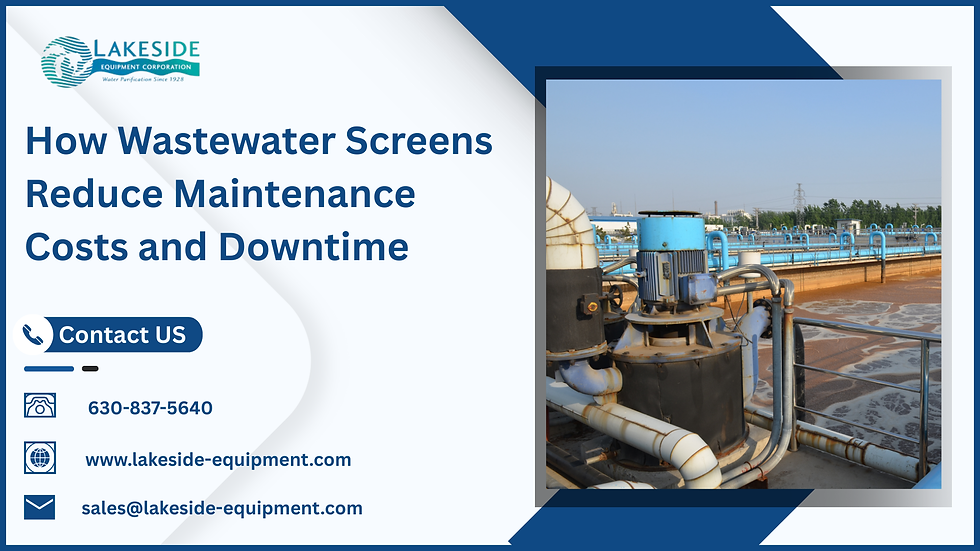How a Wastewater Clarifier Mitigates Environmental Impact
- lakesideequipment

- Mar 27
- 4 min read
Pollution of water is increasingly turning out to be an issue, and cities and industries are seeking greener solutions in wastewater treatment. A wastewater clarifier is an integral unit to prevent impairment to the environment through proper settling of suspended particles, removal of impurities, and release of cleaner discharge to water bodies naturally. Integrated with pre-treatment plants like wastewater bar screens and FOG screening, a clarifier forms the basic part of wastewater treatment through the green solution.

Learning How to Operate a Wastewater Clarifier
Wastewater clarifier is a very critical part of the treatment system, a part that removes solids from liquids by sedimentation. The heavy solids, when being fed to the clarifier, will settle at the bottom by gravity while the light solids such as grease and oils float and skimmed off. This reduces the load considerably on downstream treatment systems, and the entire process is more efficient and eco-friendlier.
Primary Functions of a Wastewater Clarifier:
Solid Separation – Efficient separation of suspended solids before secondary treatment.
Sludge Collection – Concentrates settled solids for treatment or disposal.
Effluent Quality Improvement – Ejects turbidity and impurities, leading to clearer water effluent.
Improved Efficiency – Optimizes biological and chemical treatment operations by eliminating solid loads.
How a Wastewater Clarifier Reduces Environmental Load
1. Removal of Pollutants in Water Bodies
Untreated sewage carries comes with a mixture of waste pollutants that include organic waste, heavy metals, and toxic pathogens. The clarifier completely removes these waste pollutants to a large extent before discharge, safeguarding rivers, lakes, and oceans from nutrient overload and toxic exposure. This avoids algal blooms, oxygen depletion, and aquatic ecosystem disruption.
2. Increasing Treatment Plant Efficiency
By having the capacity to remove the bulk of suspended solids, clarifiers reduce pressure on downstream filtration and biological treatment. This reduces energy needs for the aeration system and chemicals in advanced treatment processes, making wastewater treatment even more sustainable.
3. Enhancement of sludge management and resource recovery
The sludge taken out of the bottom of a clarifier is rich in valuable organic material and nutrients for reuse. A lot of it, today, is fed to anaerobic digestion or composting for biogas or soil conditioner production to reduce waste going to landfills and increase material recoveries.
4. Avoiding Pipe Clogging and Equipment Damage
When a wastewater clarifier is combined with a wastewater bar screen, large solids, and debris are caught before they clog pipes or ruin costly equipment. Bar screens catch items like plastics, rags, and debris, avoiding downtime and cost savings.
5. Fat, Oil, and Grease (FOG) Pollution Management
FOG buildup is a significant problem in wastewater treatment and causes pipe clogging, odors, and system inefficiency. Fat, oil, and grease screening keeps these substances from going into the clarifier and makes it easier to operate and eliminates grease buildup on sewers and treatment plants.
The Relationship Between Pre-Treatment and Clarification
A wastewater treatment system is optimally effective when each step plays a role in cooperation. The clarifier operates most efficiently when pre-treatment systems eliminate huge impurities ahead of time.
Why Pre-Treatment is Important:
Wastewater Bar Screens – Eliminates large solids to avoid pump and clarifier part wear.
Fat, Oil, and Grease Screening – Avoids FOG clogging and provides more efficient clarifier performance.
Grit Removal Systems – Removes sand and other hard grits that may settle in tanks and promote wear.
With these pre-treatment steps integrated effectively, the clarifier can now be dedicated to fine sedimentation, resulting in a better-quality effluent and a more effective treatment process.
Sustainable Wastewater Management: The Future of Clarification
1. Advanced Clarifier Technologies
The new clarifier design is enhancing efficiency and sustainability in terms of enhanced sludge thickening, automatic sludge withdrawal, and efficient designs. Lamella plate clarifiers and dissolved air flotation (DAF) systems are the technologies that further optimize solid-liquid separation toward cleaner discharge.
2. Treated Water Reuse and Recycling
Local governments and industries are progressively adopting water reuse schemes. Effluent from clarifiers can be treated to high quality for non-potable uses, for instance, irrigation, cooling, and industrial uses. This alleviates pressure on freshwater resources and promotes circular water use.
3. Environmental Accountability and Regulation Compliance
Tight environmental laws require wastewater treatment plants to maintain certain discharge standards. Well-maintained clarifiers allow plants to comply with national and local wastewater policy, reducing legal liabilities and increasing corporate social responsibility efforts.
Conclusion: A Cleaner Future with Wastewater Clarifiers
Wastewater clarifier is a reliable tool in environmental protection which is used to allow industries and municipalities to reduce water contamination, increase efficiency of treatment, and facilitate wastewater management to be feasible. With a wastewater bar screen and screening of fat, oil, and grease, its efficiency is enhanced, and systems of water treatment function effectively and efficiently.
Take Action for Sustainable Water Management
Are you seeking to maximize wastewater treatment efficiency and minimize your ecological footprint? Investing in a trusted clarifier system is a step in the right direction. Contact a wastewater treatment specialist today to learn more about tailored solutions for your facility!




Comments